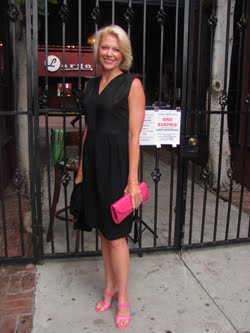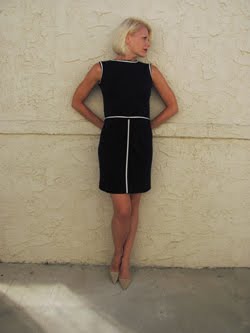The timing is perfect to share a film that has made a huge impact on me in matters of style, Richard Brooks' 1958 classic
Cat on a Hot Tin Roof. Not only is it based on a steamy Southern play that seems just right for this hot holiday weekend, but the movie's costumes are designed by my hero
Helen Rose. I just finished
filming an interview with Turner Classic Movies' Scott McGee on Monday where we discussed three of Helen's best that are showing in July--
Mogambo (1953),
Butterfield 8 (1960), and
The Courtship of Eddie's Father (1962). Though not included in this month's schedule,
Cat on a Hot Tin Roof is very much a part of the same style story and I wanted to show it here to lay a little foundation for Helen's aesthetic before my podcast airs. This film makes a strong statement of her style and even acts as the backbone for many other costumes, such as those in
Butterfield 8. I think you'll see why it's a wardrobe that I have found hugely influential in my own personal style.
Helen Rose absolutely loved Elizabeth Taylor and this really shines through in Cat's wardrobe. It was a case of costume designer and star working together in perfect harmony; Elizabeth even fought to include Helen's white chiffon dress in the movie when a more plain shirtdress was preferred by the studio. Then their relationship grew even stronger when Elizabeth's husband, producer Mike Todd, suddenly died in a plane crash during filming. The news was devastating...the couple shared a young daughter and there had been no one in Elizabeth's life who loved her like Mike. She almost couldn't make it back. Yet somehow there were parallels in Tennessee Williams' character of Maggie the Cat that Elizabeth could relate to. Playing that part and having Helen by her side really saved her life during that tragic time. Incredibly, I'm hard-pressed to think of another movie where Elizabeth looked more beautiful...clearly a comment on both her staggering strength and the wardrobe that her dear friend Helen wrapped lovingly around her.
That wardrobe for Cat on a Hot Tin Roof succinctly sums up Helen Rose's style and it has taught me some valuable lessons in design. In only three outfits, you are able to experience Helen's talented range...from lingerie to a practical blouse and skirt to a glamorous gown. You see her passion for color, revealed in the smart and simple accent of an orange belt. You see her adherence to clean lines and astute use of fabric; though most of the wardrobe is in shades of white, you don't really register its monchromatic nature due to carefully chosen fabrics that make each piece special. And of course they all show a sophistication and sexiness that is communicated through her commitment to perfect fit. Helen Rose's wardrobe in Cat on a Hot Tin Roof is classic and timeless elegance at its best. This movie is over 50-years-old, yet absolutely everything could be worn today and still be completely stunning. I'd love to take it as my own.

Elizabeth's perfect opening outfit was a great inspiration for my personal style. White silk shortsleeve blouse (with covered buttons), orange belt, cream heather wool skirt, striped handbag, kitten heels, diamond pendant necklace, gold bangle bracelets, and gold hoop earrings.
In describing Big Daddy's eyes still appreciating her figure,
Maggie has a moment that seems an inspiration for 1960's
The Graduate
"What is the victory of a cat on a hot tin roof, Maggie?"
"Just staying on it, I guess...as long as she can."
Brick leaves Maggie to head to Big Daddy's party alone,
which gets her entangled with her nightmarish "no-neck" nieces and nephews
Maggie the Cat's white slip is an essential costume whenever performing this play,
but only Elizabeth is lucky enough to have Helen Rose design and tailor it perfectly to her.
The result? Stunning from every angle.
This white chiffon dress was later labeled "The Cat" and copies were sold to women across the country,
including and especially through Helen Rose's own couture collection
A somewhat simpler silk version of "The Cat" that I found years ago made by J. Crew
Even when playing an alcoholic, Paul is gorgeous and classic in his white button-down and camel cords
Learning about Big Daddy's mortality brings real change to members of the family
and Maggie and Brick reunite in a kiss


























































































































